#this is based off a pulp art cover. which i eluded to but
Text
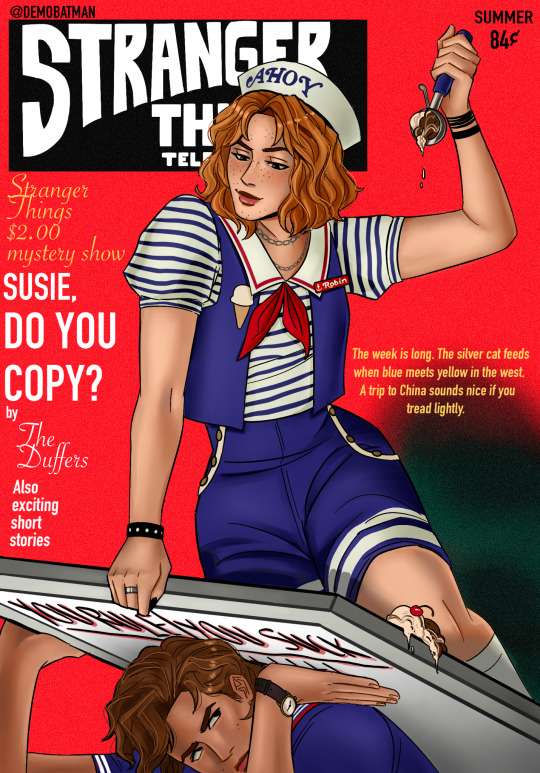
pulp art cover stobin 😎
(no background vers. below the fold)

;P
#this is based off a pulp art cover. which i eluded to but#yeah im really into pulp art rn check it out#anywhoo#finally finished her#love this piece hope yall do too i actually put effort into it#that whiteboard gave me so much trouble#take her for what she is....#i missed tumblr :/#im working on a new years drawing rn but i wanted to go ahead and post this#my art#stobin#platonic stobin#do people actually use stobin as romantic? im forever going to assume no#robin buckley#steve harrington#scoops ahoy#scoops troop#stranger things#stranger things 3#stranger things fanart#robin buckley fanart#steve harrington fanart#stobin fanart#breh#if you read this hi :)
2K notes
·
View notes
Text
The Derrick: Part II - Making Faces With My Friends
Once upon a time, designers were able to make games without graphics. Dungeon Masters rendered breathtaking worlds full of beauty and danger thanks to the amazing power of IMAGINEOVISION, a game engine that required only the human voice and the creativity of its players. Choose Your Own Adventure books and text-only computer games formalized the process into descriptive chunks of text between which the player had to choose, again without relying on a single pixel to aid -- or to hinder -- the player’s imagination. The power of decision-based storytelling was, and still is, one of the most compelling forms of gameplay available, but the introduction of computer graphics into the adventure genre with Mystery House forever changed the game. In order to attract and hold the attention of a modern gamer, even the best text-based adventure usually requires at least a modicum of eye-candy.
As we discussed last time, The Derrick will primarily take the form of a text adventure. In order to illuminate the people and places of Adams, Oklahoma, I’ll be creating not only the story and design for the game, but also the pixel art as well -- a first in my 27 years of game development. Because I’m not a naturally talented artist, it’s taken me several years to develop my art style, and what follows is a brief exploration of how I’ve developed the approach that I’ll be using in The Derrick.
* * *
I’ve always wanted to be an artist. I’ve envied so many of my friends who could sit down with a sketch pad and a pencil and just DRAW anything they wanted. My friend Kenneth Mayfield valiantly spent many hours trying to teach me, and he let me watch as he worked with an airbrush to create the covers of many of the Starfleet Battles strategy games. I picked up as much as I could from him, and even got to the point that I could paint halfway decent nebulae and planets, but mastery with traditional media eluded me. My hand eye co-ordination was poor, and no matter how long I worked at it, I never felt like I was making measurable progress. I might have given up on it entirely if Photoshop hadn’t come along in the early ‘90s to show me another way.
My first experiments with digital photo manipulation were typical surrealism. I cloned my dad and made him sit in his own lap. I placed myself on the cover of important magazines. I did all the silly things that most beginners did with Photoshop, and learned how to blend out scratches and obliterate wrinkles from extant photos. But not too long after I began to experiment with the tool, I began to see it not only as a way to change photos, but also to create entirely new images from scratch. I could make up for my natural deficits in hand eye co-ordination by zooming in and editing pixel by pixel, and I could undo mistakes with a simple keyclick. The program didn’t give me the talent that I didn’t have, of course, but it did provide me with the confidence that I might be able to grow and develop in a way that I hadn’t been possible with mere paint and canvas.
I’ll be the first to admit that my first fully digital “painting” was terrible. I was no better an artist than I had been in junior high, but it wasn’t a bad place from which to start.
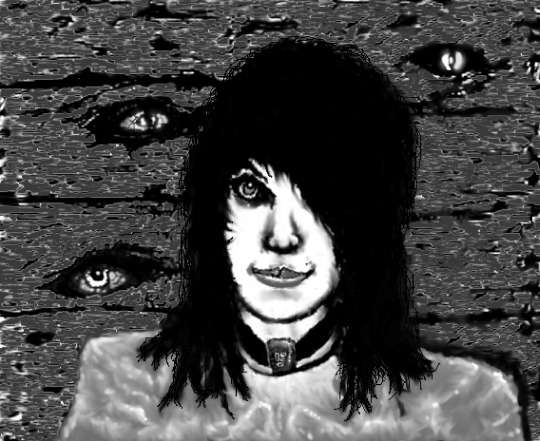
WALL OF EYES - As a whole, my first digital painting was terrible, but isolated bits of it revealed that I might be able to do things with digital painting that I hadn’t been able to master with traditional techniques.
When I got to work on my first painting, I’d had no concrete plan for what I wanted to draw. I started with the face of a cyber-punk girl and worked outward, but everything about her showed off my weaknesses as an artist. She had no structure to her face, the balance was wrong, her proportions were deformed -- from head to toe she was a nebulous mess. I’d also put zero thought into her background before starting, and as a result had to retroactively paint in a wall around her rather than painting her over it (a process that would have been a lot easier if Photoshop had had layers, but that feature wouldn’t come along for a few more years). Slowly the wall took on a kind of life of its own, becoming a rotting wood-plank fence. As the gaps and holes began to appear, my mind began to wonder what might be lurking behind them. It became evident to me that the real subjects of the painting were the eyes behind the wall rather than the girl in front of it. “Wall of Eyes” would name itself, and would later lead to two “sequel” images.
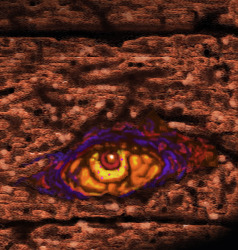
COULD SOMEBODY GET ME SOME VISINE? - Using the power of layers in Photoshop allowed me to “focus” more on fine details of the image.
With the original version of “Wall of Eyes,” I’d felt extreme hesitation at trying to fix any aspect of the image for fear of destroying what few elements I’d liked. The introduction of layers into later versions of Photoshop, however gave me not only a new way to experiment, but it also made me look at the creation process in an entirely different way.
In traditional art, it’s very customary to “build up” an image one layer at a time, painting several coats of translucent paint over each under until a net color or other effect is achieved (a core lesson I’d learned from painting nebulaes). With layers in Photoshop, I realized I could achieve the same effect without running the risk of messing up coats of paint (which would require destroying and painting over flubbed layers.) I could simply lay down different colors and textures and then alter their opacity however I desired. I could also reorder the layers in an instant, and change how they mixed with one another. Ultimately it began to feel more like the process of creating a collage, and it was freeing to realize that I could experiment without fear of messing something up.
My first use of this new feature was to return to “Wall of Eyes” and enlarge one eye that I’d found particularly menacing. Inspired by an old comic book cover, I recolored my “refocused” painting with lurid, pulp comic colors.

THE THING IN THE BOX - Taking center stage, the eye pops even more with contrasting values of heat and cold, and even greater layers of detail veining its malevolent gaze.
As I continued to toy with it and refine, I “cooled down” the fence with tones of moonlight to draw contrast with that hellish eye, and lavished more details on the eyeball itself. Using layers not only of color but also adjustments to saturation, and contrast, and other elements, I arrived at a final nightmarish image of something that none of us wants to find beneath our beds.
When I started thinking about the character portraits for The Derrick, I realized that a lot of the lessons I’d learned about painting could be used in the modification of existing materials. I could take photos of friends of mine and transform them into heavily stylized portraits that would fit the mood and style of the game I wanted to create. My portrait transformation for Delphine Mack is a fairly good example. I began with a photo of my friend Sarah Berry in vintage clothes appropriate to our 1920s setting.

The original image was black and white, and Sarah was posed against a crowded black background that had to be knocked out in order to make room for a different environment. Finding the boundaries between her dark dress and the dark background were a challenge, but it was an important step in isolating her for modification. Next, I began to hand tint the image for a slightly vintage-postcard look, and applied filters to create a paint-like “surface” to the image.
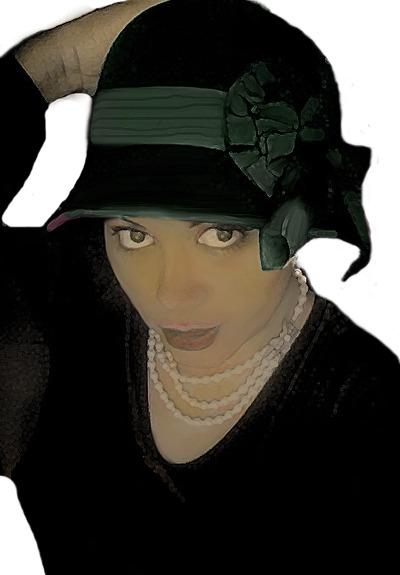
Next I turned towards the creation of a mysterious background, cloaking her in a graveyard-like fog of blue that fits the mood of the game. It felt as though she should be creeping around in graveyards or down at the riverboat dock.
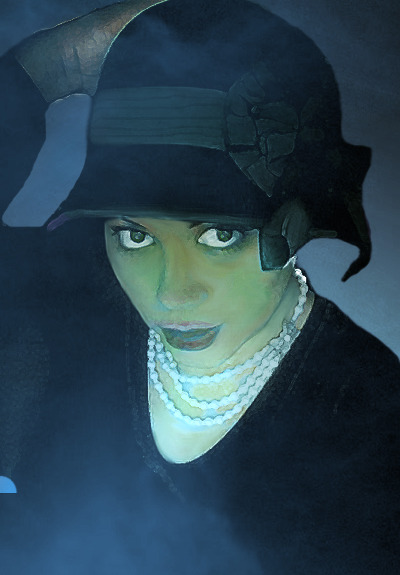
Once the fog was done, I realized that I liked it, but it seemed to compress the image into a single plane, and the color was too monochromatic. So, for a remedy, I created masks to draw a noirish slash of light across her face, while also creating contrasting bands of orange and red behind and below her for a final mysterious effect.

The irony of Delphine’s portrait creation is that I hadn’t meant for her to be a major character in The Derrick. She was intended only to be one of several non-player characters with whom the player could interact during the course of the game. But as I watched her come alive during the creation of her portrait, I began to see her as a daring and brilliant protagonist that would be very different than your usual Lovecraftian hero, and a perfect centerpiece for the tale.
Many of the other characters you’ll meet in The Derrick likewise found their narratives while I was busy “painting” their faces, some of which required a great deal more compositing of elements and layers than Delphine. Phineas Book is a great example of portrait that actually required the combination of several disparate elements -- one man’s face, another person’s hands, a suit that was appropriate for the time period, and a theatrical-looking fireplace that provided the perfect backdrop. The fire itself was hand painted for final effect, as were the eyes and other smaller elements of the scene.
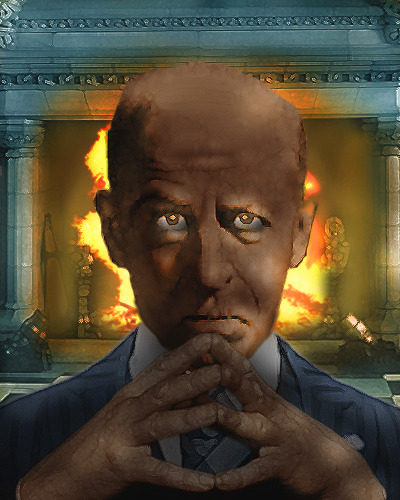
0 notes